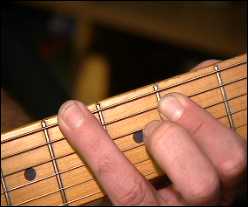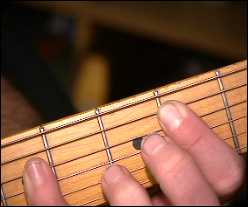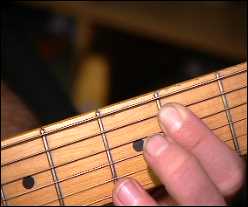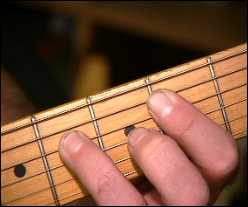Scroll through the lesson and click on notation/video/audio links to load the interactive players.
Please subscribe to get full access to all lessons for only $7.95/month PLUS 1 week free trial.

Riff Interactive lessons are
LESS expensive and
MORE interactive than alternatives!
More Info
|
|
| Lesson Subject:
Blues Legends II |
| What you learn:
Freddie King Style |
| Teacher: Michael Johnson |
Michael: This
interactive lesson covers in the
style of Freddie King. Freddie spearheaded the modern Chicago blues scene and
has inspired many guitarist, the likes of Stevie Ray Vaughan. His style features
a staccato and sharp attacks on his blues licks, but with a melodic edge. They're great
licks for any blues guitar fan, check out the lesson sample:
Michael:
Let's get started, our progression is based on the key of E, we'll use a I. IV,
V progression common for most blues.
Michael:
Can you tell me what the chords would
be?
skarz: E, A,
B
Michael:
Thanks skarz! Here's our first jam
track, notice the bass and guitar parts:
Looping Jam Track 1
Michael: Here comes
the tab for the progression on the jam
track.
Michael:
Notice how the progression is structured using the I, IV, V and how
the progression is a bit different from the other 8 bar blues progressions
it goes:
I, IV, I, IV, I, V, IV, I,
V
Michael:
Notice between the main riff how it
follows the bass, the first progression has a descending chromatic line that
resolves on the E before repeating. You can use the mouse to highlight and
repeat any section of the interactive tab this will help you isolate a section
that needs practice. The coming guitar licks will use the Em Blues
scale.
Michael:
Here's our first lick:
Lick 1
Michael:
Notice the phrasing in this lick, try playing over the jam track, the emphasis is actually on the rests, this allows room for the vocals and the grove of the
band to stand out. Freddie would usually blurt out tight little guitar licks in
between the vocals this was signature to his style. Our next lick uses the same
phrasing:
Lick 2
Michael:
The first portion of this lick starts in the major pentatonic scale and jumps
back to the open Em blues pattern.
Lick 3
Michael:
Notice how these licks start on the V then IV and I, here's another
lick:
Lick 4
Michael:
This uses more of the staccato type licks, this actually uses the major pentatonic
scale pattern in the open position and then jumps back into the minor
blues.
skarz: Do
you have to think about those scales while your playing or does it just
flow?
Michael:
It helps to have the pattern envisioned
in your mind, it's the foundation of all these licks and helps you jump between
them quickly. Here's another lick that follows the V, IV,
I.
Lick 5
skarz:
What is
the best way to memorize patterns, horizontally or
vertically?
ton:
I can only memorize them vertically.
Michael:
Good question skarz, it depends on the
scale, in this case vertically. Scales are the foundation that helps you
visualize where to play and where not, that's why I always stress learning the
scales and always refer to them in the lessons
skarz:
So that
last lick would be in 4th position
right?
Michael:
When you hear the V (B) played you play
the lick over it, you can use this next lick at the end of the phrase, does
anybody know what the term would be for playing a lick at that time? Brian:
turnaround
skarz: Yep
turnaround
Michael: Thanks Brian and
Skarz!
skarz:
Man this is cool, I'm actually learning something.
Michael:
Yes, a turnaround ends the progression
and can even be used to start a progression, one example is Red House, by Jimi
Hendrix.
skarz:
Buddy Guy does that allot doesn't he?
Michael:
Correct skarz!
Lick 6
Michael:
Now let's
try a counter lick you can play over the progression.
Michael:
This is a great sounding lick! This lick kind of reminds me of Ted Nugent's "Hey
Baby."
skarz:
sweeet
Michael:
Here are some pictures of how you can
position your hand.





Michael:
Notice how I anchor my 1st finger on the
2nd fret of the 4th & 5th strings, you can also use chord position and pick
the notes, I really like this next lick:
Lick 7
Michael:
The chords are actually based on the C#m and C#b5, kind of a cool finger-picking
triad thing, it all comes together when you hear Lesson Sample at the beginning
of the lesson.
Michael: See you
next lesson!
|
<< load notation from left
|
|
<< load audio from left
|
<< load audio from left
|